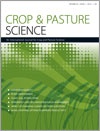CP12393Identification and mapping of a stripe rust resistance gene in spring wheat germplasm HRMSN-81 from CIMMYT
Stripe rust (or yellow rust), caused by the fungus Puccinia striiformis f. sp. tritici (Pst), is one of the important foliar diseases of wheat and responsible for low yield. Spring wheat germplasm, HRMSN-81, with resistance to the most dominant races in China, was crossed with susceptible wheat genotype Taichung 29 and genetic analysis showed that HRMSN-81 has a single dominant gene conferring all-stage resistance. The identification of the gene YrHRMSN-81 and the determination of the flanking markers should be useful for its rapid transfer to wheat breeding programs.




